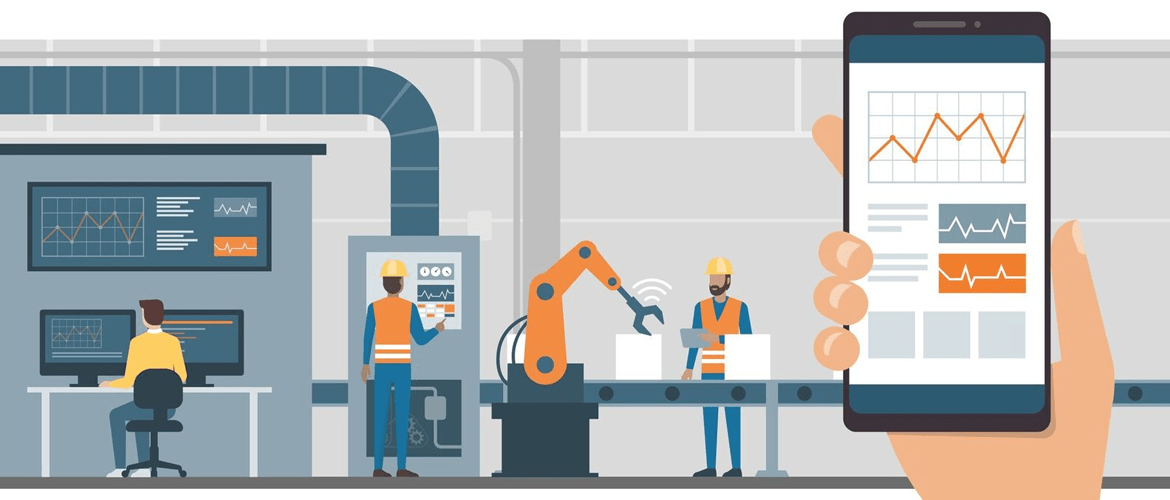Even for industry-leading manufacturers, making the move from manual processes towards a “digital transformation” is not without its challenges. One of the biggest hurdles is deciphering what YOUR organization’s Industry 4.0 journey looks like, unique to your own industry, customers, and manufacturing blueprint. Ultimately, there isn’t a one-size-fits-all method for embarking on the Industry 4.0 journey, but there ARE a few common in-roads to achieve sustained success.
In this blog post we’ll cover four potential starting points to jump start your efforts. Keep in mind that each of these key elements of digital innovation—IIoT connectivity, smart applications, and advanced analytics—will eventually play a critical role in your factory. Regardless of where you choose to begin, this framework is meant to create an architecture into which you can implement small projects.
Choosing a pilot project for your Industry 4.0 journey requires that leaders consider the following:
- What does the company want to achieve? Don't lose sight of the forest for the trees. Consider your company's C-Level strategic objectives and allow them to guide your choice.
- What's coming up next? If there are larger implementation projects that you eventually want to tackle, consider how this pilot project could affect them.
- Is the project too ambitious? Too simple? The goal is to demonstrate to top management that Industry 4.0 and IIoT are movements in which the company needs to partake. Be realistic, but aim to prove significant benefits.
 Starting Point 1 - Define your Vision
Starting Point 1 - Define your Vision
Before embarking on any digitalization initiative, it is crucial first to define where you are today. Once that assessment has been completed, only then can you begin to map out where you want to be tomorrow, and then five years down the line. Before you begin to evaluate technologies, you should outline your strategic vision, goals and KPIs based on the value and impact they will have on your company. Just because there may be a “bleeding-edge” technology on the market, doesn’t automatically equate to delivering value for your customers.
Use your customer base to help guide your digitalization journey to ensure that the focus remains on improving and elevating overall customer experience and satisfaction. Then you can begin to prioritize your investments and projects based on areas that have the biggest gaps and can produce the greatest opportunity and value.
 Starting Point 2 – Connectivity
Starting Point 2 – Connectivity
According to a recent study by PricewaterhouseCoopers, by the start of 2018, there were 260.9 million M2M connections worldwide, growing at a CAGR of 22.6% since 2012. Beginning an Industry 4.0 journey with connectivity is a strong choice that can enhance future implementation projects. It involves advanced technologies and capabilities such as MES/ERP, IIoT, M2M (machine-to-machine), and Smart Devices, and is ideal if your environment lacks an IoT infrastructure, your Information Technology (IT) /Operational Technology (OT) are not converged, or your machines and smart devices are underutilized due to a lack of data-sharing.
A connectivity-based pilot project requires manufacturers to embrace the IIoT in areas of their manufacturing operations. This can take the form of an Manufacturing Execution Software (MES) System installation, an Enterprise Resource Planning (ERP) System/(MES) System convergence project or enhancing smart device communication—all of which hinge upon data-sharing for operational excellence. To capitalize on the connected ecosystem, organizations need to start looking at seamless integration and data exchange with suppliers, customers, and other external stakeholders.
This is when architecture and standards play a very critical role in breaking down the barriers between disconnected systems and devices as well as removing the reliance on custom integrations. The Connected Ecosystem brings a new wave of opportunities not only in automation, optimization and smart manufacturing but now enables manufacturers to move towards an “on demand,” highly adaptable service model. Bridging the digital and the physical enable possibilities such as remote monitoring, diagnostics, services & control, track & trace, energy management, and so on.
 Starting Point 3 – User Adoption/Change Management
Starting Point 3 – User Adoption/Change Management
A component that is often overlooked is the challenge of change and the “people piece.” Change management in conjunction with hiring talent and upskilling are enablers for Industry 4.0 adoption. By deploying a solution that has a positive user experience, is easy to configure, yet offers robust capabilities, companies can transform their employees’ experience as well as retention rates, satisfaction levels and of course, productivity.
MES empowers operators to leverage specialized manufacturing insight without taking excessive time for cross-training, quickly establishing a high level of team-wide flexibility. When surveyed, more than 90% of leading manufacturers said that cross-trained operators were instrumental in achieving flexibility.
 Starting Point 4 – Analytics
Starting Point 4 – Analytics
The number one technology priority of high-growth manufacturing companies is enhanced data availability, demonstrating the power of Industry 4.0’s advanced analytical capabilities. Industry 4.0 pilot projects that focus on analytics will continually enhance operations throughout the process of digital transformation. Ideal for manufacturers who wish to gain insights that fuel operational excellence, analytical advancement projects will ultimately assist in building a roadmap for future smart factory innovations.
Graduating from low-value diagnostic and descriptive analytics to high-value prescriptive and predictive insights requires smart devices for data collection across the factory floor, as well as a converged IT/OT environment to infuse meaning into every data point. By implementing Industry 4.0 Big Data, Machine Learning, and AI techniques, manufacturers can do much more than recognize key trends—they can optimize and simulate operational excellence, power new perspectives for statistical process control and business management, set objectives that deliver real value, and answer questions they didn’t even know to ask. In fact, 33% of manufacturers expect to increase their revenue thanks to Industrial Analytics.
Regardless of where you choose to start your IIoT Industry 4.0 journey, each of these four elements of digital innovation will eventually play a key role in bringing greater speed, innovation and adaptability to your factory environment. From establishing internal and external communication capabilities to sharing data, in today’s connected digital factory, each project will ultimately interact. Manufacturers preparing to implement Industry 4.0 capabilities should also be aware of a strategic tool with the power to jumpstart digital transformation: a best-in-class MES. You can learn more here about Aegis Software's FactoryLogix®, an industry-leading MES platform, that is bringing Industry 4.0 benefits to leading manufacturers worldwide.
If you're interested to find out more, download the full whitepaper, “Your Industry 4.0 Journey - A Practical Guide to Attaining Industry 4.0 Benefits in Your Manufacturing Operation.”
You can also instantly view the infographic, The Industry 4.0 Journey - Strategic Digital Transformation, One Step at a Time with no registration required.
Sign up for our blog
Stay up-to-date on the latest in manufacturing trends, insights and best practices.





